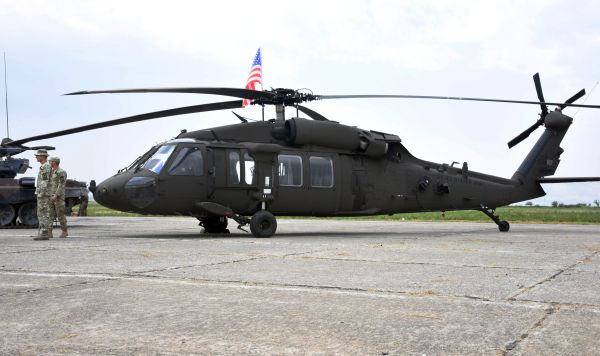
40 years of Black Hawk helicopter service
A UH-60L with 105mm howitzers is taken off during an exercise at Fort Drum, New York on July 18, 2012. US Army
October 31, 1978 Sikorsky UH-60A Black Hawk helicopters entered service with the US Army. For 40 years, these helicopters have been used as a base medium transport, medical evacuation, search and rescue and special platform in the US military. With further upgrades, the Black Hawk should remain in service until at least 2050.
Currently, about 4 are used in the world. H-60 helicopters. Approximately 1200 of them are Black Hawks in the latest version of the H-60M. The largest user of the Black Hawk is the US Army, which has about 2150 copies in various modifications. In the US Army, Black Hawk helicopters have already flown more than 10 million hours.
In the late 60s, the US military formulated initial requirements for a new helicopter to replace the multipurpose UH-1 Iroquois helicopter. A program called UTTAS (Utility Tactical Transport Aircraft System) was launched, i.e. "multipurpose tactical air transport system". At the same time, the army initiated a program to create a new turboshaft engine, thanks to which the General Electric T700 family of new power plants was implemented. In January 1972, the Army applied for the UTTAS tender. The specification, developed on the basis of the experience of the Vietnam War, assumed that the new helicopter should be highly reliable, resistant to small arms fire, easier and cheaper to operate. It was supposed to have two engines, dual hydraulic, electrical and control systems, a fuel system with a given resistance to small arms fire and impact on the ground during an emergency landing, a transmission capable of operating half an hour after an oil leak, a cabin capable of withstanding an emergency landing, armored seats for crew and passengers, wheeled chassis with oil shock absorbers and quieter and stronger rotors.
The helicopter was to have a crew of four and a passenger cabin for eleven fully equipped soldiers. The characteristics of the new helicopter included: cruising speed min. 272 km/h, vertical climb speed min. 137 m / min, the possibility of hovering at a height of 1220 m at an air temperature of + 35 ° C, and the duration of the flight with a full load was to be 2,3 hours. One of the main requirements of the UTTAS program was the ability to load a helicopter onto a C-141 Starlifter or C-5 Galaxy transport aircraft without complicated disassembly. This determined the dimensions of the helicopter (especially the height) and forced the use of a folding main rotor, tail and landing gear with the possibility of compression (lowering).
Two applicants took part in the tender: Sikorsky with the prototype YUH-60A (model S-70) and Boeing-Vertol with the YUH-61A (model 179). At the request of the army, both prototypes used General Electric T700-GE-700 engines with a maximum power of 1622 hp. (1216 kW). Sikorsky built four YUH-60A prototypes, the first of which flew on October 17, 1974. In March 1976, three YUH-60As were delivered to the army, and Sikorsky used the fourth prototype for his own tests.
On December 23, 1976, Sikorsky was declared the winner of the UTTAS program, receiving a contract to begin small-scale production of the UH-60A. The new helicopter was soon renamed Black Hawk. The first UH-60A was handed over to the army on October 31, 1978. In June 1979, UH-60A helicopters were used by the 101st Combat Aviation Brigade (BAB) of the 101st Airborne Division of the Airborne Forces.
In the passenger configuration (3-4-4 seats), the UH-60A was capable of carrying 11 fully equipped soldiers. In the sanitary-evacuation configuration, after the dismantling of eight passenger seats, he carried four stretchers. On an external hitch, he could carry cargo weighing up to 3600 kg. A single UH-60A was capable of carrying a 102-mm M105 howitzer weighing 1496 kg on an external hook, and in the cockpit its entire crew of four people and 30 rounds of ammunition. The side windows are adapted for mounting two 144-mm M-60D machine guns on universal M7,62 mounts. The M144 can also be equipped with the M7,62D/H and M240 Minigun 134mm machine guns. Two 15-mm machine guns GAU-16 / A, GAU-18A or GAU-12,7A can be installed in the floor of the transport cabin on special columns, aimed at the sides and firing through the open loading hatch.
The UH-60A is equipped with VHF-FM, UHF-FM and VHF-AM/FM radios and an Alien Identification System (IFF). The main means of protection consisted of universal thermal and anti-radar M130 cartridge ejectors installed on both sides of the tail boom. At the turn of the 80s and 90s, helicopters received the AN / APR-39 (V) 1 radar warning system and the AN / ALQ-144 (V) active infrared jamming station.
UH-60A Black Hawk helicopters were produced in 1978-1989. At that time, the US Army received approximately 980 UH-60As. There are currently only about 380 helicopters in this version. In recent years, all UH-60A engines have received T700-GE-701D engines, the same ones that are installed on UH-60M helicopters. However, the gears were not replaced and the UH-60A does not benefit from the excess power generated by the new engines. In 2005, the plan to upgrade the remaining UH-60As to M standard was abandoned and a decision was made to procure more brand new UH-60Ms.